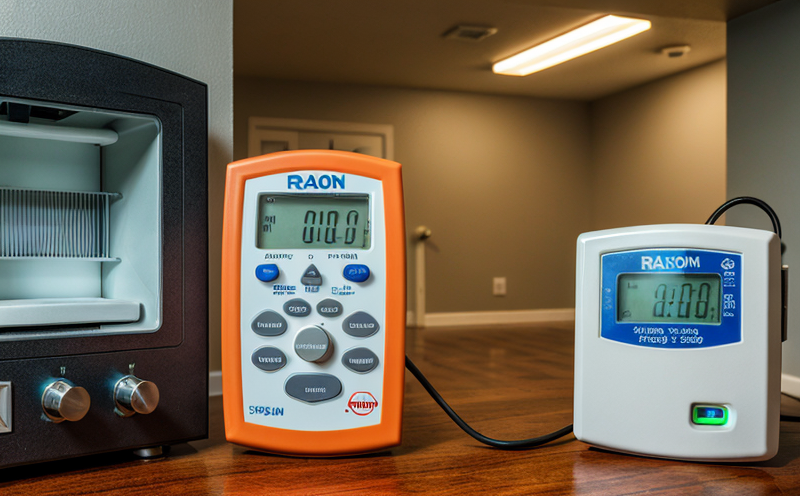ISO 11665-3 Continuous Radon Monitoring in Buildings
The ISO 11665-3 standard provides a comprehensive framework for continuous radon monitoring within buildings. This service ensures that indoor environments meet strict international standards, which are crucial for protecting public health and safety.
Radon is a colorless, odorless gas produced naturally by the decay of uranium in soil, rocks, and water. It enters buildings through cracks in floors, walls, sumps, and drains. Prolonged exposure to elevated radon levels can lead to lung cancer, making accurate monitoring essential.
The ISO 11665-3 standard specifies procedures for the continuous measurement of radon concentration in indoor air. It emphasizes real-time monitoring, which allows for immediate detection of any anomalies or fluctuations in radon levels. This approach is particularly beneficial in environments where variations can occur due to changes in building occupancy, weather conditions, or HVAC systems.
The service typically involves the installation and calibration of continuous radon monitors within designated areas of a building. These devices are capable of providing real-time data that can be monitored remotely or downloaded for analysis. The system is designed to ensure consistent accuracy and reliability over extended periods.
Continuous monitoring provides several advantages over periodic sampling methods, including:
- Precision: Continuous monitors offer precise measurements by capturing fluctuations in radon levels throughout the day.
- Reproducibility: The data collected is consistent and repeatable, providing a clear picture of long-term trends.
- Timeliness: Immediate detection of any spikes allows for prompt corrective action.
- Auditing: Continuous monitoring provides robust audit trails that are valuable for regulatory compliance.
In addition to the technical aspects, continuous radon monitoring also supports a variety of applications, including:
- Occupant safety and health in residential and commercial buildings.
- Compliance with international standards like ISO 11665-3.
- Risk assessment for potential future developments or renovations.
- Evaluation of the effectiveness of mitigation strategies post-installation.
The service is particularly important in sectors such as residential construction, healthcare facilities, schools, and government buildings. These environments are more susceptible to radon accumulation due to their enclosed nature and proximity to soil sources. Ensuring compliance with ISO 11665-3 not only protects the health of occupants but also supports the overall sustainability goals of these organizations.
Continuous monitoring aligns with the broader trend towards sustainable building practices, emphasizing indoor air quality as a critical component of environmental responsibility. By integrating this service into existing processes, organizations can demonstrate their commitment to occupant well-being and regulatory adherence.
Scope and Methodology
The scope of ISO 11665-3 continuous radon monitoring in buildings encompasses the entire lifecycle of a monitoring project. This includes site selection, installation, calibration, operation, data analysis, and reporting. The methodology is designed to ensure that all stages are conducted with precision and adherence to international standards.
Site selection is critical for obtaining accurate results. Factors such as building orientation, proximity to soil sources, and local weather patterns must be considered. Once the site is selected, the installation of continuous radon monitors requires careful placement to avoid interference from external sources or obstructions that could affect readings.
Calibration ensures that the instruments are operating within acceptable tolerances. This process involves comparing the monitor's output against a known standard source. Regular calibration is essential for maintaining accuracy over time, especially in environments where radon levels can fluctuate significantly.
The operation of continuous monitors is straightforward but requires regular maintenance to ensure optimal performance. This includes cleaning the device periodically and checking for any signs of wear or damage. Data analysis involves interpreting the raw data collected by the monitor, which may include trends over time, anomalies, and comparisons with historical data.
Reporting provides a clear summary of the monitoring results. This report is essential for stakeholders who need to understand the current state of radon levels within the building. The report typically includes detailed graphs, charts, and tables that illustrate key findings. It may also include recommendations for addressing any issues identified during the monitoring process.
The methodology ensures that all stages are conducted in a manner consistent with ISO 11665-3. This standard provides clear guidelines on how to perform each step accurately and consistently. Compliance with these standards is crucial for ensuring reliable data and meeting regulatory requirements.
International Acceptance and Recognition
The ISO 11665-3 continuous radon monitoring service is widely recognized and accepted across numerous countries, including the United States, Canada, Europe, and Asia. The standard's rigorous approach to indoor air quality measurement has earned it a reputation for reliability and accuracy.
In the U.S., this service aligns with regulations set forth by organizations such as the Environmental Protection Agency (EPA) and state health departments. Similarly, in Canada, compliance with ISO 11665-3 is encouraged to meet provincial standards. In Europe, several countries have integrated this approach into their national building codes.
The service's international recognition extends beyond regulatory compliance. Many organizations choose to implement continuous radon monitoring as part of their broader sustainability initiatives. This commitment showcases a proactive stance towards occupant safety and environmental responsibility.
Recognition from various sectors further underscores the importance of this service. Healthcare facilities, educational institutions, government buildings, and residential developments all benefit from the insights provided by continuous monitoring. The data generated can inform decisions about necessary mitigation strategies and contribute to overall improvements in indoor air quality.
The widespread acceptance of ISO 11665-3 reflects its effectiveness in addressing a critical public health issue. By providing accurate and reliable radon measurements, this service plays a vital role in safeguarding the well-being of individuals exposed to potentially harmful levels of this gas. The standard's global reach ensures that best practices are consistently applied, contributing to higher standards of indoor air quality worldwide.





